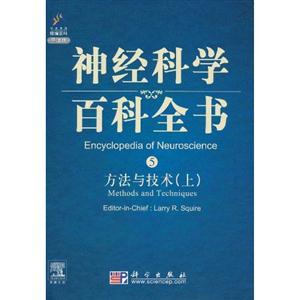方法與技術-神經科學百科全書-上-5 版權信息
- ISBN:9787030280855
- 條形碼:9787030280855 ; 978-7-03-028085-5
- 裝幀:暫無
- 冊數:暫無
- 重量:暫無
- 所屬分類:>>
方法與技術-神經科學百科全書-上-5 本書特色
《神經科學百科全書5:方法與技術(上導讀版)》是由科學出版社出版的。
方法與技術-神經科學百科全書-上-5 目錄
Aging and Memory in AnimalsAging: Invertebrate Models of Normal Brain AgingAlzheimer's Disease: Transgenic Mouse ModelsAnimal Models of Alzheimer's DiseaseAnimal Models of AmnesiaAnimal Models of Huntington's DiseaseAnimal Models of Inherited Retinal DegenerationsAnimal Models of Motor and Sensory Neuron DiseaseAnimal Models of Parkinson's DiseaseAnimal Models of Stroke BAC Transgenesis: Cell-Type Specific Expression in the Nervous SystemDrosophila Apterous Neurons: From Stem Cell to Unique NeuronDrug Addiction: Behavioral Pharmacology of Drug Addiction in RatsEpisodic Memory: Assessment in AnimalsExecutive Function and Higher-Order Cognition: Assessment in AnimalsInherited Macular Degenerations: Animal ModelsInvertebrate Models to Study Learning and Memory: LymnaeaLearning and Memory in Invertebrate Models: TritoniaLearning and Memory m Invertebrates: Aplysia ..Learning and Memory m Invertebrates: C-ElegansLearning and Memory m Invertebrates: DrosophilaLearning and Memory in Invertebrates: HermissendaLearning and Memory m Invertebrates: Honey BeeLearning and Memory m Invertebrates: LimaxLearning and Memory m Invertebrates: MollusksMammalian Sleep and Circadian Rhythms: FliesNeural Induction in ChicksNon-Primate Models of Normal Brain AgingProcedural Learning in AnimalsRodent AgingSpatial Memory: Assessment in AnimalsTransgenic Models of Neurodegenerative DiseaseVelociGene and VelociMouse: High-Throughput Approaches for Generating TargetedMutations in Mice on a Genome-Wide ScaleAtomic Force Microscopy MethodologiesBAC Use in the Study of the CNS 'Cell Culture: Autonomic and Enteric NeuronsCell Culture: Primary Neural CellsCellular Dynamics Revealed by Digital Holographic Microscopy..Chromaffin Cells: Model Cells for Neuronal Cell BiologyDecoding Neuron Transcriptome by SAGEEngineering Viruses for CNS studiesFluorescence Microscopy in the NeurosciencesFluorescent Biomarkers in NeuronsGlial Ion Homeostasis: A Fluorescence Microscopy ApproachImaging Studies Using Reporter-Gene Transgenic RatsMass Spectroscopy of ProteinsMemory: Genetic ApproachesMicroarray use for the Analysis of the CNSMicroglia Identification MethodsMonoamines: Release Studies .Neurophysiology: Past and PresentNeuroproteomicsNucleic Acid Introduction into Primary Neurons and GliaOligodendrocyte and Schwann Cell Identification MethodsOptical Monitoring of Exo- and EndocytosisPhotolysis of Caged Glutamate for Use in the CNSRNA Binding Protein MethodsRodent Behavior: ApproachesSingle Cell ElectroporationSingle Cell Genomic DNAAnalysisSingle Cell Molecular Analysis ProceduresSingle Cell PCR Coupled with ElectrophysiologySingle-Nucleotide Polymorphism (SNP)AnalysisSINRNA: Utility ,SynaptosomesUltrastructural Analysis of Spine PlasticityViral Vectors in the CNSConnectionist ModelsDeep Brain StimulationNeuroanatomy Methods in Humans and AnimalsNeuroinformaticsStatistical Tests and Inferences
展開全部
方法與技術-神經科學百科全書-上-5 節選
《神經科學百科全書5:方法與技術(上導讀版)》原書篇幅巨大,為所有神經科學百科全書之首。由來自世界各地的2400多位專家撰稿人合力打造,覆蓋了神經科學全部主要領域。書中每個詞條在收入書中之前均經過顧問委員會的同行評議,詞條中均含有詞匯表、引言、參考文獻和豐富的交叉參考內容。主編為著名神經科學家、美國神經科學學會前主席LarryR Squire內容平易.本科生即可讀懂。深度和廣度獨一無二.足可滿足專家學者的需要。導讀版精選原書中的部分主題,按內容重新編排,更適合國內讀者購買和閱讀。
方法與技術-神經科學百科全書-上-5 相關資料
Mice pose advantages over other species,such as rats,dogs,pigs,or primates,in several aspects:(1)It ISrelatively easy to house large numbers of them;(2)the mouse genome is better characterized than that of anyother mammaI except humans;(3)many geneticallyaltered transgenic knockout and knockin lines andgenetically characterized mouse strains are availablefor crossbreeding and further genetic analysis;(4)cognitive studies can be done in appropriate strains of mice,such as C5786/SJL and 129S6,making the mespecially relevant to the study of AD;and(5)studies in invertebrates,while useful,willlack some relevance in pharmacological studies and pathogenic in vestige.Tions To create transgenic mice with salient features of AD.investigators must take care in several aspects of design and development.The most important factors are the selection of the gene or gene variant to be expressed,the promoter driving transgene expression,the background strain of the mice. and the levels and distribution of transgenic protein expression achieved in the brain.The mouse lines with the most robust neuropathological phenotypes have been developed using the method of pronuclear microinjection oftransgenes into fertilized ocytes(Figure 1).B0th wildtype and variant human APP and tau genes have been used to generate mice that develop neuropathology related to AD.Transgenes containing mutations linked to aut osomaI dominant AD or FDTP generate morerobust neuropathology than transgenes encoding wild-type genes.Although mutations in presenilin一1 and presenilin.2 genes lead to early-onset ADin humans,mice expressing presenilin gene variants do not develop neuropathology per 5e.In the presence of human APP transgenes,howeve the presenilin gene variants accelerate plaque deposition in trans'genic mice.















